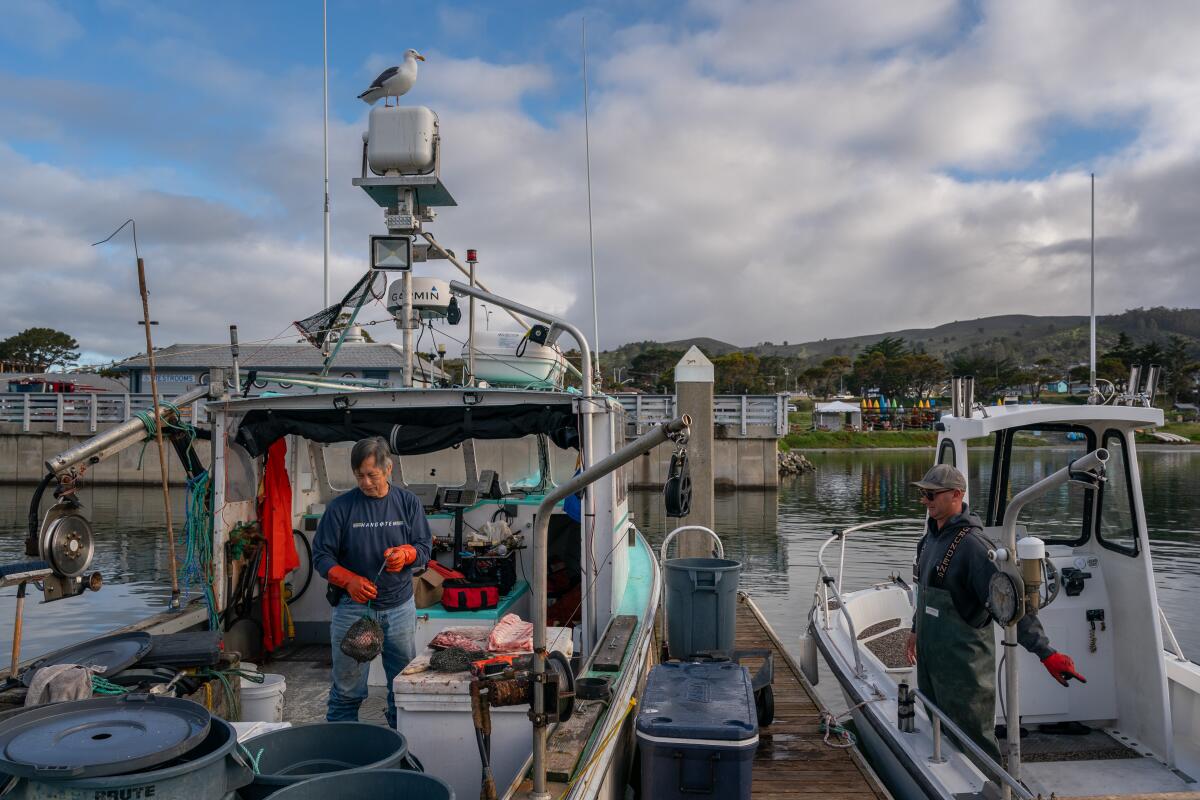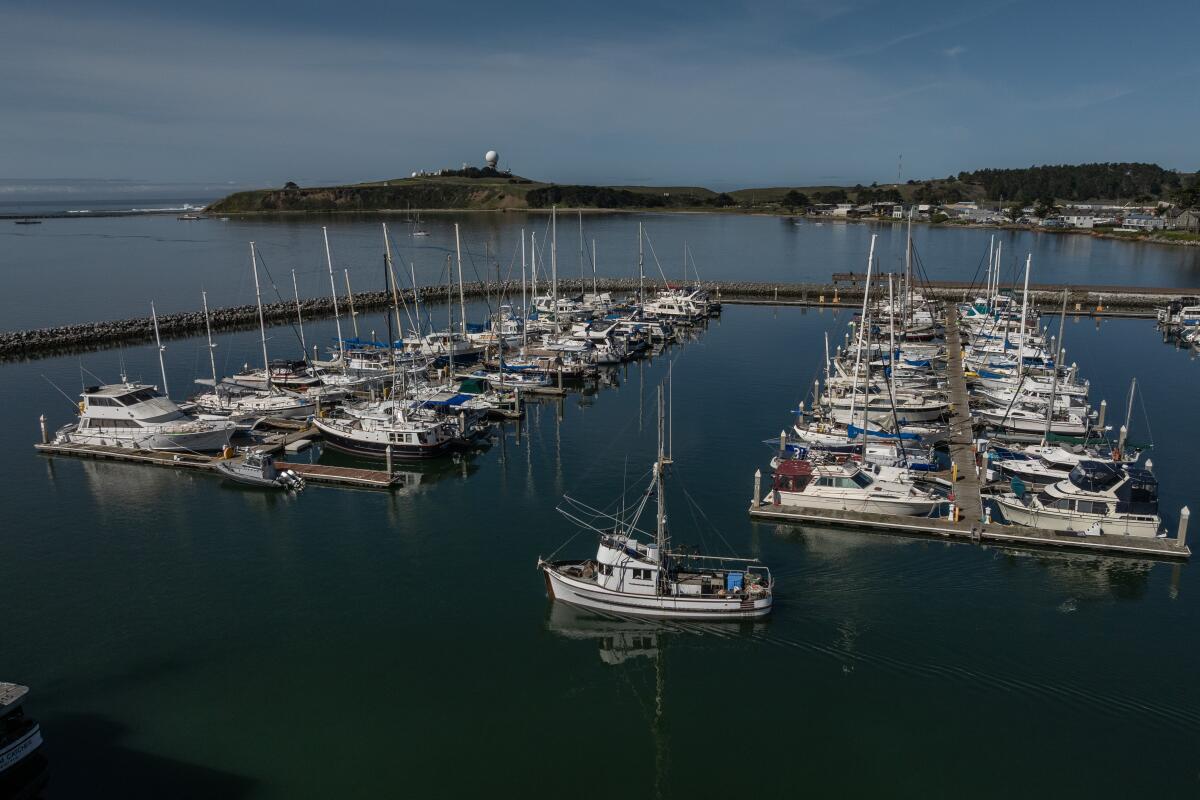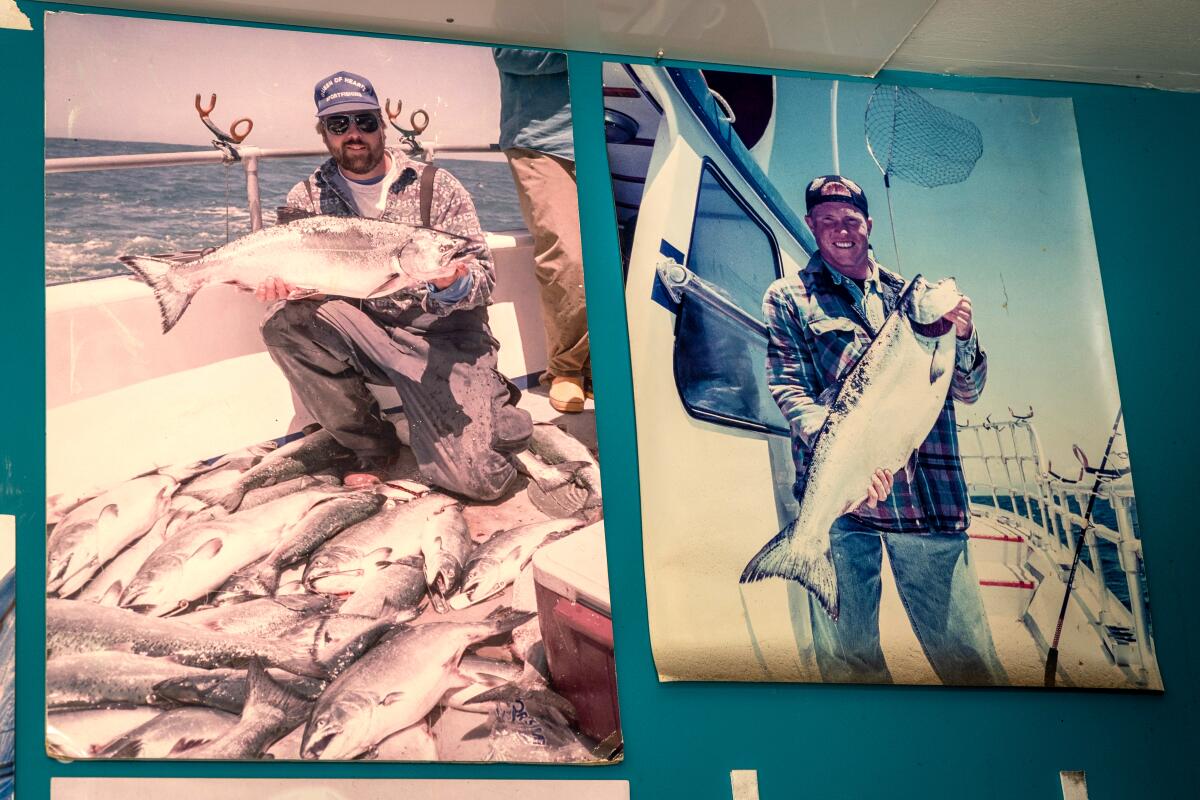California’s water outlook has brightened for now, but salmon and other fish are still in peril

Welcome to today’s edition of Boiling Point. I’m Ian James, a reporter on The Times climate and environment team, filling in for my colleague Sammy Roth.
Salmon is king.
It’s a phrase I heard more than once as I interviewed people who depend on fishing and asked them what last year’s shutdown of salmon fishing has meant for them.
Along the California coast from May to October, commercial fishing boats and sportfishing charter vessels are typically out on the ocean hauling in salmon. But low population numbers led to the cancellation of last year’s season, and this year fishery regulators will soon consider whether to ban fishing for another year, or allow a minimal season with restricted dates and catch limits.
I spoke with people in a few fishing communities to learn how they’ve been affected by the closure, and what they think about the factors that have driven declines in salmon and other fish populations.
“It’s been devastating for the small communities, the coastal communities, because that’s our main income for the summer,” said Jeremy Dierks, who lives in Bolinas and has been fishing for more than three decades.

Dierks fishes from a small boat with a rod, and sells his catch. When he was unable to fish for Chinook salmon last summer, he turned to halibut and tuna.
“It’s been a struggle. The last couple of years have probably been my worst years in my entire career,” Dierks told me.
He and others said they see various causes for the low numbers of fall-run Chinook salmon, including the dams that have eliminated fish habitat, losses to predators and how fish hatcheries are managed.
Fish also suffered during the severe three-year drought from 2020 to 2022, when at times the water flowing from Shasta Dam was so warm that it was lethal for salmon eggs in the Sacramento River.
How water is managed in the Sacramento and other rivers can make or break fish populations. And many I spoke with said they largely blame California water managers, who they say send too much water to farms and cities, depriving rivers of the cold flows salmon need to survive.
“It comes down to the water,” said Kenneth Brown, who sells fishing gear and bait at his shop Bodega Tackle in Petaluma. “It’s all water mismanagement.”
Brown said his business was down 40% because of the shutdown of salmon fishing last year, and the outlook this year isn’t much better.
“Salmon is the big one,” he said. “Salmon is a huge part of our industry for us. And it’s just devastated the whole area.”

I visited Half Moon Bay to talk with fishermen at Pillar Point Harbor, and several said they have turned to other work to make ends meet. Some said they’re putting boats up for sale.
Commercial fisherman John Schulz, who has been in the business since 1998, said his boat was tied up in port much of last year, and he is now looking to get out of fishing. Schulz said he is still hopeful that the salmon will eventually recover enough to have a full fishing season again. But the question is, “Who’s going to be here five years from now to go fishing?”
Tom Mattusch, president of the San Mateo County Harbor Commission, showed me around the harbor, where crews were unloading Dungeness crab. He fished for decades but sold his charter boat in 2021.
He shared his perspective on how California’s water management has affected salmon.
“Too much water is diverted towards farming, too much water is sent to Southern California,” Mattusch said. “But as far as salmon goes, they don’t have enough of the cold, clear, clean water that they need.”
The task for California now, he said, is to “rebalance and reimagine the things that are necessary for the salmon, to rebuild these stocks.”
“You’ve got to figure out when is the water needed for certain runs, and how do we balance the needs of people and fish,” he said.
For my story about the salmon fishing shutdown, I also spoke with Charlton “Chuck” Bonham, director of the state Department of Fish and Wildlife, who outlined the state’s plans for helping salmon populations recover.
Even as the fishery goes through this difficult time, Bonham said, state officials are focused on actions that can “change the trajectory.”
“Now is the time. Salmon is in our hands,” he said. “There’s hope. We can do this.”
On that note, here’s a look at what’s happening in California and around the West:
TOP STORIES
California is benefiting from a second wet winter, with the snowpack measuring 110% of average. Gov. Gavin Newsom joined state officials for their final snow survey of the season, where he presented a new water plan that lays out priorities for adapting to climate change. He said the state’s strategy includes moving ahead with the proposed Delta Conveyance Project, a 45-mile tunnel that would transport water beneath the Sacramento-San Joaquin River Delta. The tunnel project is controversial and faces legal challenges, but Newsom called it “one of the most important projects this state can advance.”
When it comes to snow and water, California goes through cycles of boom and bust, as the last several years have demonstrated. And our droughts and deluges are projected to become more extreme with climate change. My colleague Sean Greene produced a superb graphic illustrating the rise and fall of the Sierra Nevada snowpack over the last 20 years. He says the graphic “provides a long-term view of the state’s highly variable climate and the patterns that dictate our water fortunes.”
As for wild weather, Southern California has seen some jaw-dropping rainfall lately. As my colleagues Grace Toohey and Hayley Smith report, downtown Los Angeles has received more than 52 inches of rain in the last two water years as of this week — the second-highest amount ever recorded. There hasn’t been such a high two-year rain total since the late 1800s. As one meteorologist put it, that’s “way, way, way above normal.”
CLIMATE SCIENCE AND MORE
Last year was Earth’s hottest on record. But the sudden rise in global temperatures went far beyond what statistical climate models had predicted. What might that mean for future warming? Climate scientists are now working to try to understand why 2023 was so anomalously hot, and Hayley Smith wrote a piece for The Times examining what scientists are saying, and they have different theories.
When we talk about planet-heating greenhouse gases, the ones that are most often discussed are carbon dioxide and methane. But there are others, such as the termite killing gas sulfuryl fluoride, and it has been found to be 4,800 times more potent than carbon dioxide in trapping heat. My colleague Melody Petersen wrote about new research in which scientists were surprised to discover that California releases more of this climate-warming pesticide than all other states combined.
One way of reducing methane emissions is to compost food scraps instead of tossing the stuff in the garbage and having it decompose in a landfill. But what’s the right way to compost? Maggie Beidelman, Yadira Flores and Karen Garcia produced a helpful video explaining how to do it.
THE ENERGY TRANSITION
The U.S. Environmental Protection Agency has issued tough new emissions standards for heavy-duty trucks and buses, with the aim of cutting air pollution and addressing climate change. As L.A. Times reporter Russ Mitchell explains in an article about the new standards, California’s rules are tougher than the Biden administration’s, and are expected to remain so.
Although the federal government has sought to boost clean energy, the country has also seen an increase in production of natural gas. As Alexander C. Kaufman writes for HuffPost, the U.S. sold more liquefied natural gas on the global market than any other country last year, “surpassing yet another milestone in the nation’s transformation into a fossil fuel superpower.”
WILDLIFE IN THE WEST
Scientists are finding that there are some significant differences between populations of killer whales. The black and white whales are currently all classified as a single species, Orcinus orca, but that could change. My colleague Lila Seidman wrote a fascinating piece about new research that argues there are distinct species of orcas, and about an odd story from more than a century ago: how a San Francisco whaler in 1869 described two species of killer whales, only to have his work cast aside. Here is how Lila explains the importance of the latest findings: “Approving two newly proposed killer whale species could transform how they’re conserved — and turn a page in one of the strangest chapters in marine mammal history.”
Some types of migratory shorebirds rely on saline lakes, including Mono Lake in California and the Great Salt Lake in Utah, on their long migrations. One species, Wilson’s phalarope, has suffered declines along with the saline lakes it depends on. A coalition of environmentalists and scientists have petitioned the federal government to seek protections for Wilson’s phalaropes under the Endangered Species Act. Independent journalist Daniel Rothberg covered the groups’ effort to seek added protection for phalaropes, writing that “the last twenty years of drought and consistent demand for water have created significant challenges, drying out ecosystems and making habitats unlivable for the small invertebrates that birds like the phalarope rely on.”
My colleague Louis Sahagún wrote a surprising story about rattlesnakes that you will not want to miss. He spoke with a biologist who explained his research is showing there is a lot more to the reptiles that most people think. Here is how William Hayes, a research biologist at Loma Linda University, put it: “Rattlesnakes are among the most feared, misunderstood and abused animals of all. Yet, they are not all that different from us. They, too, have fears, emotions and find comfort in companionship.”
ONE MORE THING
Louis Sahagún has had a remarkable career at the Los Angeles Times. As a staff writer for 43 years, he has written a wide range of stories about topics ranging from religion to California’s wildlife.
While reporting, he saw levee breaks on the Mississippi River, lived through a 7.2-magnitude earthquake in a Mexico City high-rise, and chased brown tree snakes in Guam.
He was part of a team that won a Pulitzer Prize in public service in 1984 for a series on Latinos in Southern California, and in 2015 was part of a team that was a finalist for the Pulitzer Prize in breaking news.
For many years, he has unearthed unique, powerful stories that have been a central piece of The Times’ reporting on the environment and other topics in California and the West.
It’s hard for many of us in the newsroom to believe that Louis has now finished his incredible run at the newspaper and has signed off for retirement. So, as we share some of his final stories for the L.A. Times, I’d like to encourage everyone to go read some of Louis’ best work. One of his latest pieces focuses on how a global glut of wine is bringing troubles for California grape growers. Other must-read stories from the last few years include Louis’ pieces about desert tortoises, Mono Lake and California’s oldest tree.
All of his recent work can be found on his L.A. Times author page. As my colleagues and I say our farewells, we are wishing Louis the very best in his next adventures!
This is the latest edition of Boiling Point, an email newsletter about climate change and the environment in California and the American West. You can sign up for Boiling Point here. And for more climate and environment news, follow @ByIanJames and @Sammy_Roth on X.
Toward a more sustainable California
Get Boiling Point, our newsletter exploring climate change, energy and the environment, and become part of the conversation — and the solution.
You may occasionally receive promotional content from the Los Angeles Times.




